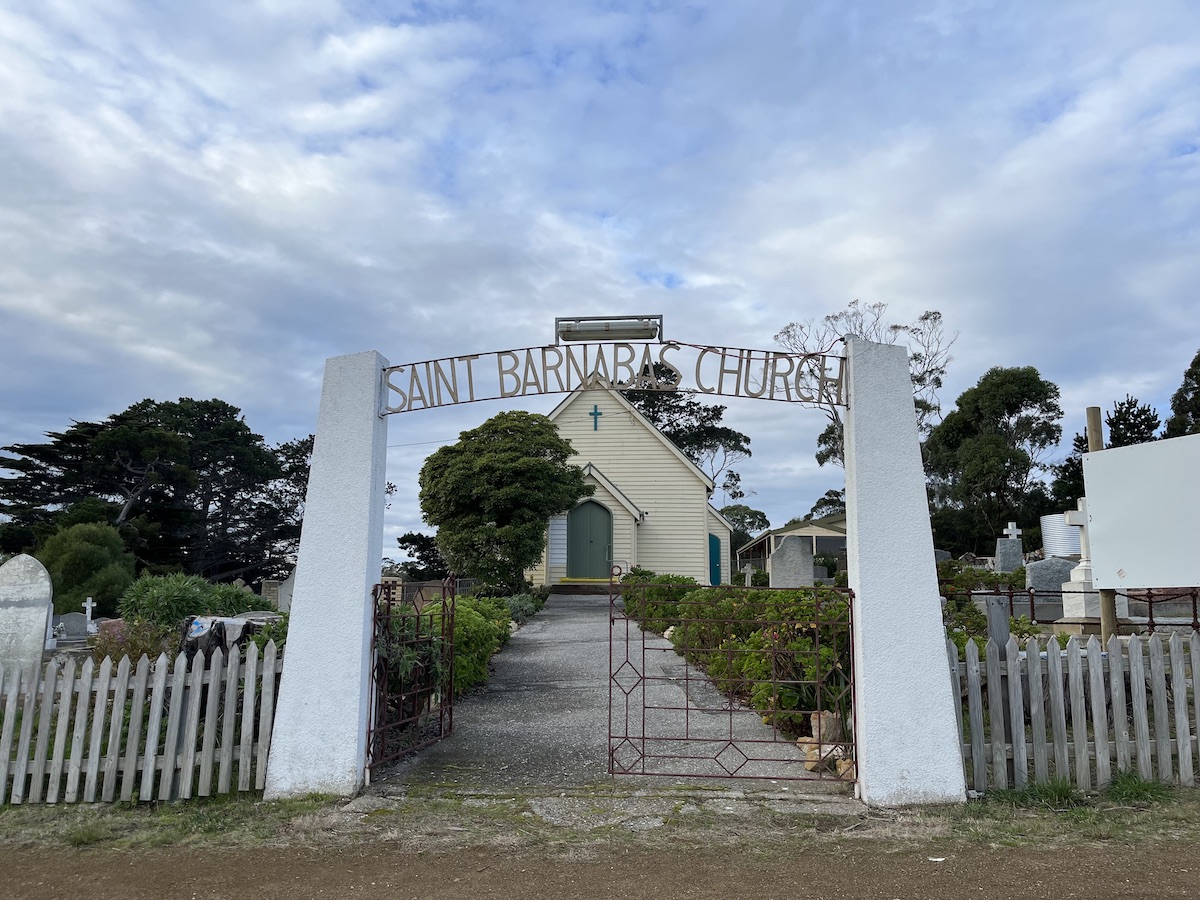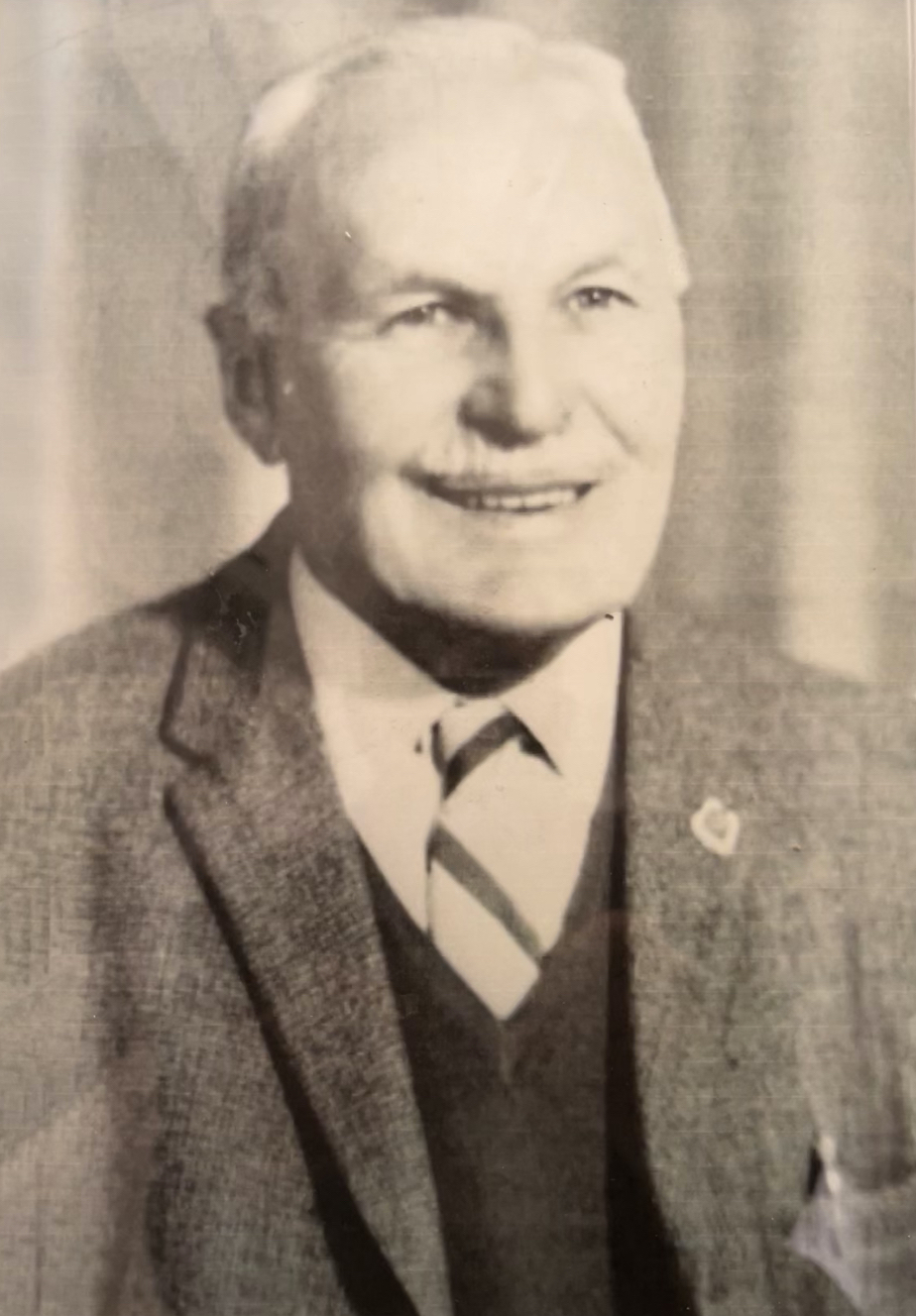Did you know the arch at the entrance to St Barnabas Church was made possible by a donation by Major Fred George who came to live at South Arm in 1950?

Frederick George was born on the 25th Day of March 1885 in the town of Ludington Northamptonshire. He was the youngest boy of seven children, four sisters and two brothers.
It appears his ambition was to be a soldier from a very young age as he enlisted in the British Army at the age of seventeen in 1902 as a driver in the Royal Field Artillery. It was guns and horse drawn wagons in those days.
At the age of 23 years Fred married Kate (Kitty) Leach at Newmark in England on the 26th June 1908. While they were in England, they raised five children, Kathleen, Frederick, Winifred, Harry and Jennie.

Fred became the Battery Accountant in 1904; with the appointment he became an acting bombardier, one stripe.
By 1914 Fred was a Sergeant, and he became the assistant to Battery Commander at practice camps in England and Wales. From his experience he became a Battery Commander in the First World War. When war broke with Germany a new Army division was formed and he was commissioned as 2/Lieut. to the 23rd Division at Aldershot.
Soon after he became adjutant of the 105th Brigade and in due course went to France with the brigade. Another officer in that brigade was 2/Lieut. Neville Fraser, who was the father of Malcolm Fraser who later became the Prime Minister of Australia.
Fred saw action in France and at the River Somme. It was at the Somme that he was wounded when a shell splinter penetrated his neck. When the splinter was removed it was given to him by the doctor. Fred was later moved to hospital in England, and when fit he was allowed to return home. Instead he went back to France and in due course became Captain and then Major while commanding a battery.
In 1917 he was posted to France, and became the acting Captain 2nd in charge of a 6 gun battery, 18 pounders. Commander Major E.C. Skinner who had been with Fred in England 1915 went on leave, leaving him in charge of the battery. In the following action on Anzac Ridge, Ypres Salient, came under heavy shelling by an enemy battery, which ignited the ammunition at their gun position. They had causalities so called for two men to help put out the burning ammunition. Had they not been able to put out the fire in the ammunition, they would have been caught in an explosion, and for this Fred was awarded the Military Cross.
In 1918 Fred saw action again. While second in charge of the 5th Division, they came under heavy fire in the final approach to the river Rhine. Fred was again wounded with a splinter from a shell burst that entered his left arm. After removal of the splinter he was posted to Cologne in Germany as Staff Captain. Soon after the armistice was called.
On his return to Cologne in Germany, Fred joined the army of occupation in a sector allotted to the British Army. The war having ended he was posted to Ireland and there commenced recruit training, which he could not take after four years of war. He then decided to retire from the army on a service pay per year. He went to college on theory of farming, crops and animals. This all took place on a poultry farm owned by Mr. Cottrell in the town of Newbury.
In 1925 Fred, Kitty and their five children immigrated to Australia, and were met in Melbourne by Sir Neville Fraser and Lady Fraser who were living in Toorak.
After a few weeks in Melbourne they moved to Tasmania. He rented a house at Kingston for the family while he had a look around for a property that would provide some income besides a home. Fred soon found just the place at Berriedale on the road to Collinsvale.
The property had a small orchard of apples, apricots etc. They had one good year and two bad ones, so he had to leave it and took on milking cows at Kingston. This property was known as Mount Pleasant, the owner was Robert Nettlefold who sold cars in Hobart. The manager was George Richardson who had several butcher shops in Hobart. (Mr. Richardson also owned the Property “Arm End” Opossum Bay 1948-50)
Between 1926 and 1940 he worked on a property for Colonel Henry Foster and his son Francis H. Foster.
On the first of February 1927 , their sixth child Charles Neville George was born.
At the outbreak of Second World War, Fred was then 55 years of age with a wide experience of the army. He joined the Australian Army at the rank of Captain and his first appointment was as an Intelligence Officer at Anglesea Barracks, Hobart.
His first job was to registrar all pigeon owners in Tasmania as they were very good at message carrying in wartime. His next appointment was to Campbell Town as Staff Captain. His years in the British Army became very useful, as he was a trained soldier, so he could train others.
During those years of war He travelled all over Australia training men in all capacities from Warrant Officers, down to Cooks. Orderlies, Clerks, Bateman and others to become trained soldiers by giving them the jobs to do, and by showing them just how to do the job, all because I had done this sort of thing myself in the British Army. For his services to the army at the end of the war 1945 he was awarded two more medals bringing his total of war medals to six, he was then sixty years of age.
Fred spent five years in the army until retiring at the age of sixty on 25th March 1945 with the rank of Major.
Fred and Kitty celebrated their golden wedding in July 1958.
Over the following years, they were able to visit England. Kitty had the enjoyment of seeing her sisters and Fred was also able to see his relatives.
On returning, they moved to their cottage at South Arm where they had happy enjoyable times. Until 1959 when Kitty developed cancer and died on the 5th June 1959.
Fred was given a farewell by the sub-branch and local people on 25th September 1959.
In September 1959, Fred moved to the Masonic Home, here he had a room and cooked all his own meals. On the 19th January 1962 he married the matron of the home Mrs. Gladys Tomlinson. They married at Wesley Church, Hobart.
They moved into the caretaker’s cottage and had a happy eight and a half years together. Gladys passed away on 13th August 1970 .
After reading the story of Fred George, it was easy to see he was a man on the move. It was no wonder he saw an opportunity to bring together those retired servicemen to the meeting he held at the Calverton Hall which led to the formation of the first South Arm RSL Sub-Branch.
Reference: Short History South Arm RSL 1952-2010 by Maurice Potter.